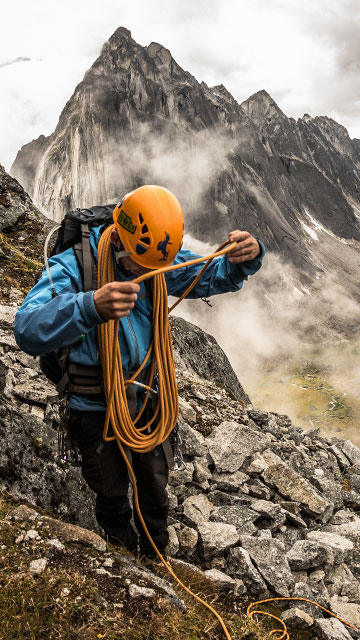
Photo: Gary Bremner
Climbing Safety and Guidelines
Nahanni National Park Reserve
Please be advised that Cirque Hike and Climb is extremely strenuous that can include hazardous terrain such as steep slopes, poor visibility, fallen trees and underbrush. This trail is considered a route-finding trail and is not maintained by Parks Canada. Before you go, please consider safety precautions, risk management and wildlife hazards. The Cirque Hike is in a remote back country setting that requires visitors to be physically and mentally prepared.
Nahanni National Park Reserve has spectacular climbing, but it isn’t the place for visitors to embark on their first trad climbing experience. Only experienced and expert outdoor climbers who are completely self-reliant should be climbing in Nahanni National Park Reserve.
All overnight visitors must reserve their trip beforehand. Registering before visiting the park and de-registering when you leave is also mandatory.
Ensure you have a safe trip.

- Research your trip. Read trip reports and dive deep into route guides. Make sure you have the skills, experience, and gear that climbing in Nahanni National Park Reserve demands.
- Make sure you have enough days to complete your objective. Weather is unpredictable in the mountains. You may end up waiting on the ground for many days for a perfect weather window to climb at your best. There are many bouldering and hiking areas in the Cirque to keep you occupied while you wait.
- After rain or snow, many climbs stay wet for days. Be aware that this adds extra hazards. It may significantly increase the difficulty of your climb and the amount of time it will take to complete.
- Fixed protection is limited and not placed or maintained by Parks Canada. Be sure to inspect each piece of protection you find on the wall for imperfections and use it at your own risk.
- Beware of all wildlife hazards. Nahanni National Park Reserve is black and grizzly bear country, so maintain your camp accordingly. The marmots and ground squirrels may also try to access unsecured food or attractants - while less dangerous to you, this can harm the animals, so please keep your camp clean.
- As clean as the mountain streams look, treat your water before you drink it. Filters, boiling, purification tabs, and steri-pens are all good options.
- Don't go anywhere without your survival gear - first aid kit, bivouac sack or small tarp, map, compass and repair kit.
- Bring your GPS, satellite communicator (e.g., InReach, SPOT, Zoleo, etc.) or satellite phone (record emergency numbers), but never expect to count on them 100 percent of the time. Complete a trip plan before leaving to circulate to your emergency contacts.
- Communicate with other parties in the area to make sure that if multiple groups have the same objective on the same day, everyone is comfortable with the plan.
Rescue Services
Nahanni National Park Reserve is a remote wilderness park and climbers should plan on being self-reliant and remember that rescue assistance may not always be immediately available, especially during stormy weather. Rescue teams capable of big wall rescue are a minimum of 48 hours away.
Weather
The weather in the remote Mackenzie Mountains varies widely at all times of the year, and conditions can change quickly. Make sure you are prepared for both sun and snow - and everything in between.
- Dress in layers. This allows you to adjust your body temperature as the weather changes.
- Always pack an extra warm layer just in case, including a toque (warm hat) and gloves.
- Pack clothing that will protect you from wind, rain, cold and snow.
- Wear sunscreen and sunglasses - harmful UV rays are extra damaging when reflected off the snow or rock faces at higher elevations.
Low-impact climbing
Low-impact climbing and mountaineering practices are critical to the future of the wilderness that makes Nahanni National Park Reserve world famous. Follow these principles as you enjoy your climbing experience:
- Carry out what you carried in.
- Do not leave fixed line, food caches, fuel, or equipment (broken or otherwise) in the park
- While tempting, don’t store food, fuel, or any animal attractant in the cabins at Glacier Lake. They are not wildlife-proof and attract porcupines, bears and other wildlife that can become habituated to the area.
- Reduce packaging to ensure you leave no trace of your journey.
- There is no deadfall at Fairy Meadows. Do not burn garbage: pack out what you brought in.
- Use the outhouse at Fairy Meadows. If that’s not possible, follow backcountry best practices and pack out your toilet paper with you. If the outhouse is full, please notify the Nahanni office (867-695-6558) as soon as you’re out of the park.
- Stick to the established trails. Alpine plants and soil are very sensitive, and can take a long time to recover after being trampled.
- Keep a distance from any wildlife you see to allow them to go about their lives undisturbed. Use a telephoto lens if you want to take a photo, and remember, drones are not permitted in national parks.
- Date modified :